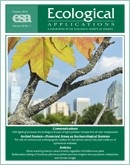|
 |
2024 |
2023
|
2021
|
2020
|
2019
|
2018
|
2017
|
2016
|
2015
|
2014 |
2013 |
2012 |2011 |2010
|<2009
... <2001 |  |  |
| | Hier
finden Sie unsere wissenschaftlichen und ein Teil der populären Publikationen.
| | [Artikel,
die noch nicht per pdf runtergeladen werden können, bitte einfach per email
anfordern ] | | | 2024
Blant M, Dulex N, Märki K, Torriani D, Müller JP. 2024. Die Kleinsäugerfauna
der Val Bever – Resultate einer Fangaktion. Jber. Natf. Ges. Graubünden 123,
Seiten 57– 62. (pdf)
Geiger
M, Taucher AL, Gloor S, Lauper M, Kiefer S, Kimmig SE, Siebert, Walter T, Zink
R, Bontadina F & Hegglin D. 2024. StadtWildTiere - added value and impact
of transnational urban wildlife community science projects. Frontiers in Ecology
and Evolution - Section Urban Ecology, (pdf,
link).
Schaub
M, Loercher F, Hegglin D, Arlettaz R. 2024. Demographic assessment of reintroduced
bearded vultures in the Alps: Success in the core, challenges in the periphery.
Ecological Solutions and Evidence, 5, e12347. (pdf,
link).
| | | | | 2023
Behr
O, Barré K, Bontadina F, Brinkmann R, Dietz M, Disca T, Froidevaux J, Ghanem S,
Huemer S, Hurst J, Kaminsky SK, Kelm V, Korner-Nievergelt F, Lauper M, Lintott
P, Newman Ch, Peterson T, Proksch J, Roemer Ch, Schorcht W, Nagy M. 2023. Standardized
and referenced acoustic monitoring reliably estimates bat fatality risk at wind
turbines: comments on ‘Limitations of acoustic monitoring at wind turbines to
evaluate fatality risk of bats‘. Mammal Review (link,
pdf+).
Berger
A, Geiger M, Taucher AL. 2023. Nachhaltiger Schutz von Igelpopulationen in
städtischen und ländlichen Lebensräumen - Sustainable protection of hedgehog populations
in urban and rural habitats. In: Voigt CC (Hrsg.): Evidenzbasiertes Wildtiermanagement.
Springer, Berlin und Heidelberg 103-125. (link,
link
ebook, pdf)
Geiger
M & Vinciguerra L. 2023. Evaluation of a facial feature to distinguish two
sympatric Water Shrew species. Hystrix It. J. Mamm. 34(2):133-136. (pdf,
link)
Kistler
C, Gloor S, Hegglin D & Bontadina F. 2023. Das Management des Fuchses sollte
auf wissenschaftlichen Grundlagen anstatt auf Annahmen basieren. In: Voigt
C. Evidenzbasiertes Wildtiermanagement (pp. 257-272). Berlin, Heidelberg: Springer
Berlin Heidelberg, 293 p. (link,
link
ebook, pdf)
Pardo
Gil M, Hegglin D, Briner T, Ruetten M, Müller N, Moré G, Frey C, Deplazes P &
Basso W. 2023. High prevalence rates of Toxoplasma gondii in cat-hunted small
mammals - Evidence for parasite induced behavioural manipulation in the natural
environment? International Journal for Parasitology: Parasites and Wildlife
20:108-116. (link,
pdf)
| |
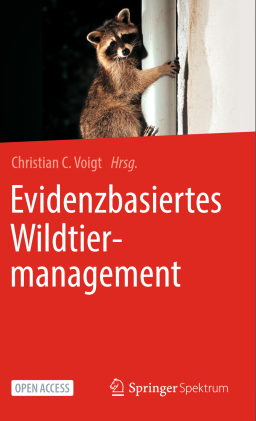 | | | 2022
Geiger M, Kistler C, Mattmann P, Jenni L, Hegglin D & Bontadina F. 2022.
Colorful collar-covers and bells reduce wildlife predation by domestic cats
in a Continental European setting. Frontiers in Ecology and Evolution 10:850442.
(link,
pdf)
Hüppi
E & Geiger M. 2022. Fast-paced city life? Tempo and mode of phenotypic changes
in urban birds from Switzerland. Ecology and Evolution, 12(8), e9217. (pdf,
link).
Müller JP, lant M, Gerber S, Maddalena T, Märki K, Dulex N.
2022. Die Kleinsäugerfauna des Puschlav – Resultate einer Fangaktion. Jber.
Natf. Ges. Graubünden 122: 11–17. (pdf,
link zur NNG).
Rauchenstein
K, Ecker K, Bader E, Ginzler C, Düggelin C, Bontadina F & Obrist MK. 2022. LiDAR
metrics predict suitable forest foraging areas of endangered Mouse-eared Bats
(Myotis myotis). Forest Ecology and Management 120210. (link,
pdf)
Vignali
S, Lörcher F, Hegglin D, Arlettaz R, Braunisch V. 2022. A predictive flight-altitude
model for avoiding future conflicts between an emblematic raptor and wind energy
development in the Swiss Alps. R. Soc. Open Sci. 9: 211041. (pdf,
link)
| | | | | 2021
Biedermann M, Karst I, Zinke O, Bontadina F, Schorcht W. 2021. Rare lesser
horseshoe bat Rhinolophus hipposideros as traffic casualty after the opening of
a motorway. ScienceMatters, 22 March 2021. doi:10.13140/RG.2.2.26079.74407
(link,
pdf)
Phipps L, Loercher F, Ball D, Marlé E. 2021. Genetic analysis reveals
the origin of a Bearded Vulture in northern Europe in summer 2020. British
Birds, 114:33-37. (link,
pdf)
Taucher
AL & Geiger M. 2021. Der Igel – Nachbar und Wildtier. Das Artporträt mit
Ratgeber für den Igelschutz. Haupt Verlag, Bern. 240 S. (link)
Vignali
S, Loercher F, Hegglin D, Arlettaz R, Braunisch V. 2021. Modelling the habitat
selection of the bearded vulture to predict areas of potential conflict with wind
energy development in the Swiss Alps. Global Ecology and Conservation 25:e01405.
(link,
pdf)
Zambelli N, Martinoli A, Bontadina F, Mattei-Roesli M & Moretti M. 2021.
Nottola di Leisler (Nyctalus leisleri, Chiroptera), specie emblematica delle
selve castanili dell'Alto Malcantone (Cantone Ticino, Svizzera). In: Moretti
M, Moretti G & Conedera M (Eds.), Memorie della Società ticinese di scienze naturali
e del Museo cantonale di storia naturale: Vol. 13. Le selve castanili della Svizzera
italiana. Aspetti storici, paesaggistici, ecologici e gestionali (pp. 175-183).
Società ticinese di scienze naturali; Museo cantonale di storia naturale. (link,
pdf)
| | |
| | 2020
Gillis-Germitsch, N., Tritten, L., Hegglin, D., Deplazes, P., & Schnyder,
M. 2020. Conquering Switzerland: emergence of Angiostrongylus vasorum over
three decades and rapid regional increase in the fox population contrasts with
the stable prevalence of lungworms. Parasitology, 1–28. (pdf)
Taucher AL & Geiger M. 2020. Dachse in den Fussstapfen der Stadtfüchse.
FaunaFocus 58:12p. (Titelseite,
link)
Taucher
AL, Gloor S, Dietrich A, Geiger M, Hegglin D, Bontadina F. 2020. Decline in
Distribution and Abundance: Urban Hedgehogs under Pressure. Animals, 10:1606
(link,
pdf)
Zingg PE & Bontadina F. 2020. Continuation of the recordings at the research
station Jungfraujoch on the activity and migration behaviour of bats. Activity
report 2020, International Foundation HFSJG, 81-83. (pdf,
link)
| | |
| | 2019
Schmieder DA, Bader E, Schönbächler C, Krättli H, Bontadina F, Obrist MK.
2019. Validierung bioakustischer Fledermausaufnahmen. Natur & Landschaft
Inside 3/19. (pdf)
Karst I, Biedermann M, Schorcht W, Bontadina F. 2019. Verhindern Schutzzäune
Kollisionen von Fledermäusen im Straßenverkehr? - Fachliche Grundlagen für die
Wirksamkeit von Querungshilfen am Beispiel der Kleinen Hufeisennase [Are fences
an effective mitigation measure to protect bats from traffic collisions?]. Naturschutz
und Landschaftsplanung 51:01. (link,
pdf)
Kister C, Gloor S & Bontadina F. 2019. Die Stadtfauna profitiert von
grüner Vielfalt - Grünräume gegen Überhitzung. COLLAGE
- Zeitschrift des Fachverbands der Schweizer RaumplanerInnen FSU. 5/19:19-20.
Koller B, Hegglin D, Schnyder M. 2019. A grid-cell based fecal sampling
scheme reveals: land-use and altitude affect prevalence rates of Angiostrongylus
vasorum and other parasites of red foxes (Vulpes vulpes). Parasitology Research.
(pdf)
Taucher A. 2019. Rückgang der Igel in der Schweiz? IN: 4. Fachtagung
- Rund um den Igel, Seewald U, Hrsg: Pro Igel e.V., pp. 19-21. ISBN 978-3-940377-19-7.
(Bestellung,
pdf)
Weinberger I, Muff S, Kranz A, Bontadina F. 2019. Riparian vegetation
provides crucial shelter for resting otters in a human-dominated landscape.
Mammalian Biology, 98:179-187. (pdf)
| | |
| |
2018
Abt G, Gloor
S, Tschander B, Lubicz E. 2018. Qualität des Grüns im Aussenraum - Befragung
von Deutschschweizer Wohnbaugenossenschaften und -Stiftungen zu Planung und Unterhalt
ihres Aussenraums. Verein Natur und Wohnen, Zürich, 80 Seiten. (website,
Bericht: link,
pdf)
Arseneau-Robar TJM, Müller E, Taucher AL, van Schaik CP, Bshary R, Willems
EP. 2018. Male monkeys use punishment and coercion to de-escalate costly intergroup
fights. Proc. R. Soc. B 285: 20172323. (pdf)
Geiger M, Taucher AL, Gloor S, Hegglin D, Bontadina F. 2018. In the footsteps
of city foxes: evidence for a rise of urban badger populations in Switzerland.
Hystrix, the Italian Journal of Mammalogy, 29(2). (link,
pdf)
Gloor
S & Göldi Hofbauer M. 2018. Der ökologische Wert von Stadtbäumen
bezüglich der Biodiversität - The ecological value of urban trees with
respect to biodiversity. Jahrbuch der Baumpflege 22:33-48. (Bestellung,
pdf)
Lehnert LS, Kramer-Schadt S, Teige T, Hoffmeister U, Popa-Lisseanu A, Bontadina
F, Ciechanowski M, Dechmann DKN , Kravchenko K, Presetnik P, Starrach M, Straube
M, Zoephel U, Voigt CC. 2018. Variability and repeatability of noctule bat
migration in Central Europe: evidence for partial and differential migration.
Proc. Roy. Soc. B. 285:20182174. (link,
pdf)
NATURA & SWILD. 2018. Mortalité causée par le parc éolien du Peuchapatte
sur les chauves-souris et évaluation de mesures de protection - Mortalität von
Fledermäusen beim Windpark Le Peuchapatte und Evaluation von Schutzmassnahmen.
Rapport de synthèse - Synthesebericht im Auftrag des Bundesamtes für Umwelt
BAFU und des Bundesamtes für Energie BFE. NATURA, Les Reussilles & SWILD,
Zürich, 126 Seiten. (pdf,
link
BFE)
| |
[Interested in an article which is not yet ready for download? Just write an email.
]
| | |
2017 Alishani M., Sherifi
K, Rexhepi A, Hamidi A, Armua-Fernandez M T, Grimm F, Hegglin D, Deplazes P. 2017.
The impact of socio-cultural factors on transmission of Taenia spp. and Echinococcus
granulosus in Kosovo. Parasitology 1-7. (link,
pdf)
Arseneau-Robar TJM, Taucher AL, Schnider AB, van Schaik CP, Willems EP. 2017.
Intra- and interindividual differences in the costs and benefits of intergroup
aggression in female vervet monkeys. Animal Behaviour 123, 129-137. (pdf)
Bader E, Bontadina F, Frey-Ehrenbold A, Schönbächler C, Zingg PE,
Obrist MK. 2017. From bat calls in the field to validated species records –
the approach of the Swiss Bat Bioacoustics Group (SBBG). 14th European Bat
Research Symposium, 1.-5. August 2017, Donostia, The Basque Country. (pdf)
Beerli O, Guerra D, Baltrunaite L, Deplazes P, Hegglin D. 2017. Microtus
arvalis and Arvicola scherman: Key Players in the Echinococcus multilocularis
Life Cycle. Frontiers in Veterinary Science 4:1–10. (link,
pdf)
Braaker S, Kormann U, Bontadina F, Obrist MK. 2017. Prediction of genetic
connectivity in urban ecosystems by combining detailed movement data, genetic
data and multi-path modelling. Landscape and Urban Planning 160:107-114. (pdf)
Craig PS, Hegglin D, Lightowlers MW, Torgerson P & Wang Q. 2017. Echinococcosis:
Control and Prevention. Advances in Parasitology 95:1-104. (in press, pdf)
Lugon A, Eicher C, Bontadina F. 2017. Fledermausschutz bei der Planung,
Gestaltung und Sanierung von Verkehrsinfrastrukturen - Arbeitsgrundlage. Im
Auftrag von BAFU und ASTRA. 78 S. (link,
pdf)
Lugon A, Eicher C, Bontadina F. 2017. Conservation des chauves-souris
dans le cadre de la planifica- tion, de l’aménagement et de l’assainissement des
infrastructures de transport – Base de travail. Sur mandat de l‘OFEV et de
l‘OFROU. 78 p. (link,
pdf)
Meschede A, Schorcht W, Karst I, Biedermann M, Fuchs D & Bontadina F.
2017. Wanderrouten der Fledermäuse. – BfN-Skripten 453, 236 S. (pdf,
link)
Otero-Abad B, Rüegg SR, Hegglin D, Deplazes P & Torgerson PR. 2017. Mathematical
modelling of Echinococcus multilocularis abundance in foxes in Zurich, Switzerland
Parasites & Vectors 10:21. (pdf,
open
access)
Ravessoud T, Ecker K, Bontadina F, Steck C, von Felten S,
Deplazes L, Krättli H, Obrist MK. 2017. Predicting commuting corridors
of bats. 14th European Bat Research Symposium, 1.-5. August 2017, Donostia,
The Basque Country. (pdf)
| | |
| |
2016 Arseneau-Robar TJM,
Müller E, Taucher AL, van Schaik CP, Willems EP. 2016. Male food defence as
a by-product of intersexual cooperation in a nonhuman primate. Scientific
Reports 6:35800. (pdf)
Arseneau-Robar TJM, Taucher AL, Müller E, van Schaik C, Bshary R, Willems
EP. 2016. Female monkeys use both the carrot and the stick to promote male
participation in intergroup fights. Proc. R. Soc. B 283:20161817. (pdf)
Dekker J, Berthinussen A, Ransmayr E, Bontadina F, Marnell F, Apoznanski
G, ... & Elmeros M. 2016. Future research needs for the mitigation of the effects
of roads on bats. CEDR Call 2013: Roads and Wildlife SafeBatPaths. (link)
Deplazes L, Frey-Ehrenbold A, Ziegler M, Bontadina F. 2016. Grosse Fledermausvielfalt
in den Waldnaturschutzgebieten des Kantons Zug. Schweizerische Zeitschrift
für Forstwesen 167:5, 278-285. (pdf,
link)
Kistler C. 2016. Fische, die sensiblen Wasserbewohner. Welt
der Tiere 1:16, 33-35. (pdf)
Obrist MK, Moretti M, Bontadina F. 2016. Der Igel zu Besuch im Garten.
Hotspot 33:28. (PDF
deutsch , PDF
en francais)
Russo D, Billington G, Bontadina F, Dekker J, Dietz
M, Gazaryan S, Jones G, Meschede A, Rebelo H, Reiter G, Ruczynski I, Tillon L
& Twisk P. 2016. Identifying key research objectives to make European forests
greener for bats. Frontiers in Ecology and Evolution - Conservation, 4:87.
(link,
PDF).
SWILD. 2016. Grosse Fledermausvielfalt in den Waldnaturschutzgebieten des Kantons
Zug. Ergebnisse von Ultraschall-Aufzeichnungen von Fledermausrufen in fünf Waldnaturschutzgebieten
des Kantons Zug in den Jahren 2010 bis 2014. Synthesebericht vom Januar 2016.
Amt für Wald und Wild, Kanton Zug, 26 Seiten. (pdf)
Weinberger IC, Muff S, de Jongh A, Kranz A & Bontadina F. 2016. Flexible
habitat selection paves the way for a recovery of otter populations in the European
Alps. Biological Conservation 199:88-95. (pdf)
Zingg PE, Bontadina F. 2016. Migrating bats cross top of Europe.
PeerJPreprints 4:e2557v1 https://doi.org/10.7287/peerj.preprints.2557v1
(pdf)
| | |
| |
2015 Arseneau JM, Taucher
AL, Van Schaik CP, Willems EP. 2015. Male monkeys fight in between-group conflicts
as protective parents and reluctant recruits. Animal Behaviour 110:39-50.
(pdf)
Biedermann M, Bontadina F, Brinkmann R, Dietz Ch, Dietz I, Karst I, Niermann I,
Schauer-Weisshahn H, Schorcht W. 2015. Case studies for the crossing behavior
over roads of the Alcathoe Bat Myotis alcathoe. 58-71. In: Bayrisches Landesamt
für Umwelt (Ed). Verbreitung und Ökologie der Nymphenfledermaus. UmweltSpezial.
Fachtagung des LfU am 22. März 2014. 154 Seiten. (pdf
27 MB, link)
Hanagasioglu M, Aschwanden J, Bontadina F & de la Puente Nilsson M. 2015.
Investigation of the effectiveness of bat and bird detection of the DTBat and
DTBird systems at Calandawind turbine. Final Report, Bundesamt für Energie,
142p. (pdf,
link)
Hegglin D, Bontadina F, Deplazes P. 2015. Human-wildlife interactions
and zoonotic transmission of Echinococcus multilocularis. Trends in Parasitology
31(5):167-173. (pdf)
Kistler C. 2015. Aquarienfische sind keine Dekoartikel. Welt
der Tiere 3:15, 46-49. (pdf)
Lurati L, Deplazes P, Hegglin D, Schnyder M. 2015. Seroepidemiological
survey and spatial analysis of the occurrence of Angiostrongylus vasorum in Swiss
dogs in relation to biogeographic aspects. Veterinary Parasitology 212:219–226.
(pdf)
Meschede A, Fuchs D, Bach L&P, Biedermann M, Blohm T, Bontadina F, Dietz
M, Fuß A, Geiger-Roswora D, Hammer M, Harbusch C, Hensle E, Hutterer R, Jokisch
S, Körber H&H, Krättli H, Mayer F, Michalczyk Ch, Moeschler P, Ohlendorf B,
Petermann R, Reiter G, Schorcht W, Stiefel D, Stutz HPB, Straube M, Teige T, Vierhaus
H, Voigt ChC, Wegleitner S, Wohlgemuth R, Zahn A, Zöphel U. 2015. Phenology
of migrating bats crossing Central Europe. Poster at 4th International Berlin
Bat Meeting, 13-15. March 2015.
Raoul F, Hegglin D, Giraudoux P. 2015.
Trophic ecology, behaviour and host population dynamics in Echinococcus multilocularis
transmission. Veterinary Parasitology 213:162–171. (pdf)
Taucher A & Gloor S. 2015. Citizen Science: Gemeinsam Wissen schaffen.
FaunaFocus 22:12p. (link)
| |
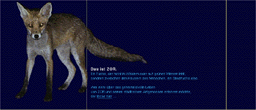 |
| |
2014 Bohnenstengel T, Krättli H,
Obrist MKO, Bontadina F, Jaberg C, Ruedi M, Moeschler P. 2014. Rote Liste der
Fledermäuse der Schweiz, Stand 2011. Bundesamt für Umwelt, Bern;
Centre Suisse de Cartographie de la Faune, Neuchâtel; Centres suisses de coordination
pour l’étude et la protection des Chauves-souris, Genève und Zürich; WSL,
Birmensdorf. Umwelt Vollzug: in press.
Bontadina F, Beck A, Dietrich
A, Dobner M, Eicher C, Frey-Ehrenbold A, Krainer K, Loercher F, Maerki K, Mattei-Roesli
M, Mixanig H, Plank M, Vorauer A, Wegleitner S, Widerin K, Wieser D, Wimmer B,
Reiter G. 2014. Massive bat migration across the Alps: implications for wind
energy development. XIIIth European Bat Research Symposium 2014. ISBN 978-953-6904-30-3.
(pdf)
Braaker S, Moretti M, Boesch R, Ghazoul J, Obrist MKO, Bontadina F. 2014.
Assessing habitat connectivity for ground-dwelling animals in an urban environment.
Ecological Applications 24:1583–1595. (pdf,
10 MB; pdf+,
10 MB)
Giavi S, Moretti M, Bontadina F, Zambelli N, Schaub M. 2014. Seasonal
survival probabilities suggest low migration mortality in migrating bats. PLOSone
9(1): e85628. (pdf)
Guerra D, Hegglin D, Bacciarini L, Schnyder M, Deplazes P. 2014. Stability
of the southern European border of Echinococcus multilocularis in the Alps: evidence
that Microtus arvalis is a limiting factor. Parasitology, in press. (preprint
pdf, 0.7
MB)
Krättli H, Brossard C, Moeschler P, Magnin B, Bontadina F. 2014.
Integration of bat conservation concerns in the development of wind energy
projects in Switzerland. XIIIth European Bat Research Symposium 2014. ISBN
978-953-6904-30-3. (pdf,
poster)
Krättli H, Brossard C, Moeschler P, Magnin B, Bontadina F. 2014. Integration
des Fledermausschutzes bei der Realisierung von Windenergieprojekten in der Schweiz.
Tagung "Landschaft und Energie" an der WSL vom 25. Nov. 2014. (Poster)
Lewis FI, Otero-Abad B, Hegglin D, Deplazes P, Torgerson PR. 2014. Dynamics
of the Force of Infection: Insights from Echinococcus multilocularis Infection
in Foxes. PLoS Negl Trop Dis 8(3): e2731. (pdf,
link)
Obrist MK, Bohnenstengel T, Krättli H, Bontadina F, Jaberg C, Ruedi
M, Moeschler P. 2014. Calls for conservation: how echolocation served the red
list compilation of Swiss bats. XIIIth European Bat Research Symposium 2014.
ISBN 978-953-6904-30-3. (pdf)
| |
|
| |
2013 Ashrafi S, Rutishauser M, Ecker K,
Obrist M, Arlettaz R, Bontadina F. 2013. Habitat selection of three cryptic
Plecotus bat species in the European Alps reveals contrasting implications for
conservation. Biodiversity and Conservation 22:2751–2766. (pdf)
Comte S, Raton V, Raoul F, Hegglin D, Giraudoux P, Deplazes P, Favier
S, Gottschek D, Umhang G, Boué F, Combes B. 2013. Fox baiting against Echinococcus
multilocularis: Contrasted achievements among two medium size cities. Preventive
veterinary medicine 111(1-2):147–155. (pdf)
Frey-Ehrenbold A, Bontadina F, Arlettaz R, Obrist M. 2013. Landscape connectivity,
habitat structure and activity of bat guilds in farmland-dominated matrices.
Journal of Applied Ecology 50:252-261. (pdf)
Hegglin D, Deplazes P. 2013. Control of Echinococcus multilocularis: Strategies,
feasibility and cost–benefit analyses. International Journal for Parasitology
43:327-337. (pdf)
Kistler C, Hegglin D, von Wattenwyl K, Bontadina F. 2013. Is electric
fencing an efficient and animal-friendly tool to prevent stone martens from entering
buildings? European Journal of Wildlife Research 59:905–909. (pdf)
Loercher F, Keller L, Hegglin D. 2013. Low genetic diversity of the reintroduced
bearded vulture (Gypaetus barbatus) population in the Alps calls for further releases.
5th Symposium for Research in Protected Areas: 473 - 478. (pdf,
link)
Margalida A, Carrete M, Hegglin D, Serrano D, Arenas R, Donázar JA. 2013.
Uneven Large-Scale Movement Patterns in Wild and Reintroduced Pre-Adult Bearded
Vultures: Conservation Implications. PLoS ONE 8(6): e65857 (pdf,
link)
Meschede A, Fuchs D, Biedermann M, Blohm T, Bontadina F, Fuss A, Hammer M,
Hensle E, Hutterer R, Krättli H, Mayer F, Moeschler P, Ohlendorf B, Reiter
G, Schorcht W, Stutz H-P B, Teige T, Voigt Ch C, Wegleitner S, Zahn A, Zöphel
U. 2013. Phenology of migrating bats crossing Central Europe. Poster at
3rd International Berlin Bat Meeting: Bats in the Anthropocene, 1st - 3rd March
2013 at Berlin, Germany.
Reiter G, Pölzer E, Mixanig H, Bontadina F,
Hüttmeir U. 2013. Impact of landscape fragmentation on a specialised woodland
bat, Rhinolophus hipposideros. Mammalian Biology 78:283-289. (pdf)
Szentkuti S, Bontadina F, Spada M, Moretti M, Zambelli N, Martinoli A, Arlettaz
R. 2013. Factors underlying migratory bat aggregations in chestnut groves.
Endangered Species Research 21: 105–114. (pdf)
2012 Brinkmann R, Biedermann M, Bontadina
F, Dietz M, Hintemann G, Karst I, Schmidt C, Schorcht W. 2012. Planung und
Gestaltung von Querungshilfen für Fledermäuse. – Eine Arbeitshilfe für Straßenbauvorhaben
im Freistaat Sachsen. Sächsisches Staatsministerium für Wirtschaft, Arbeit und
Verkehr, 116 Seiten. (pdf)
Kaufmann C, Steinmann IC, Hegglin D, Schaffner F, Mathis A. 2012. Spatio-temporal
occurrence of Culicoides biting midges in the climatic regions of Switzerland,
along with large scale species identification by MALDI-TOF mass spectrometry.
Parasites & Vectors 2012, 5:246. (link,
pdf)
Kistler C. 2012. The Importance of Environmental Enrichment for Explorative
Animals in Captivity - Red Foxes (Vulpes vulpes) and Cyprinid Fish as Case Studies.
PhD thesis, University of Zurich, Switzerland. (link,
pdf)
Maddalena T, Blant
M, Marchesi P, Märki K, Wattenwyl K von, Torriani D, Zanini M. 2012. L’Arvicola
di Savi (Pitymys savii de Sélys- Longchamps, 1838) nel Cantone Ticino (Svizzera),
situazione attuale e proposte per la sua conservazione. Bolletino della Società
ticinese di Scienze naturali 100:133-134. (pdf)
Rutishauser MD, Bontadina F, Braunisch V, Ashrafi S, Arlettaz R. 2012. The
challenge posed by newly discovered cryptic species: disentangling the environmental
niches of long-eared bats. Diversity and Distributions, 1-12. (pdf)
Takumi K, Hegglin D, Deplazes P, Gottstein B, Teunis P, Van der Giessen J.
2012. Mapping the increasing risk of human alveolar echinococcosis in Limburg,
The Netherlands. Epidemiology and infection, 140(5), 867-871. (pdf)
2011
Ashrafi S, Beck A, Rutishauser
M, Arlettaz R, Bontadina F. 2011. Trophic niche partitioning of cryptic species
of long-eared bats in Switzerland: implications for conservation. European
Journal of Wildlife Research. Online First. (pdf)
Burlet P, Deplazes P and Hegglin D. 2011. Age, season and spatio-temporal factors
affecting the prevalence of Echinococcus multilocularis and Taenia taeniaeformis
in Arvicola terrestris. Parasites & Vectors 4:6 (link,
pdf). Fontana
S, Sattler T, Bontadina F, Moretti M. 2011. How to manage the urban green to
improve bird diversity and community structure. Landscape and Urban Planning
101: 278–285. (pdf)
Kistler C, Hegglin D, Würbel H, König B. 2011. Preference for structured environment
in zebrafish (Danio rerio) and checker barbs (Puntius oligolepis). Applied
Animal Behaviour Science 135: 318-327. (pdf) Mattei-Roesli
M, Obrist MK, Ehrenbold A, Bontadina F. 2011. Signs of the extinct bat Myotis
capaccinii (Chiroptera, Vespertilionidae) in Canton Ticino, Switzerland, after
a century. Bolletino della Società ticinese di Scienze naturali 99: 111-115.
(pdf) Obrist
MK, Rathey E, Bontadina F, Martinoli A, Conedera M, Christe P, Moretti M. 2011.
Response of bat species to sylvo-pastoral abandonment. Forest Ecology and
Management, 261:3, 789–798 (pdf). Tschanz,
B, Hegglin, D, Gloor S & Bontadina F. 2011. Hunters and non-hunters: skewed
predation rate by domestic cats in a rural village. European Journal of Wildlife
Research, 57:597–602. (pdf)
2010
Ashrafi S, Bontadina F, Kiefer A, Pavlinic I & Arlettaz
R. 2010. Multiple morphological characters needed for field identification
of cryptic long-eared bat species around the Swiss Alps. Journal of Zoology,
London 281: 241–248. (pdf,
0.3 MB) Burlet P, Deplazes P, Hegglin D. 2010. Efficient age determination:
how freezing affects eye
lens weight of the small rodent species Arvicola
terrestris. European Journal of Wildlife Research 56: 685-688. (pdf,
0.1 MB) Kistler C, Hegglin D, Würbel H, König B. 2010. Structural
enrichment and enclosure use in an opportunistic carnivore: the red fox (Vulpes
vulpes). Animal Welfare 19(4): 391-400. (pdf,
0.2 MB)
Sattler T, Borcard D, Arlettaz R, Bontadina F, Legendre P,
Obrist MK, Moretti M. 2010. Spider, bee and bird communities in cities are
shaped by environmental control and high stochasticity. Ecology 91(11), 3343-3353.
(pdf, 0.4 MB) Wibbelt
G, Kurth A, Hellmann D, Weishaar M, Barlow A, Veith M, Prüger J, Görföl
T, Grosche L, Bontadina F, Zöphel U, Seidl H-P, Cryan P, Blehert DS. 2010.
White-Nose Syndrome fungus (Geomyces destructans) in bats, Europe. Emerging
Infectious Diseases 16(8):1237-1242. (pdf,
link)
2009
Kistler, C, Hegglin, D, Würbel,
H, König, B. 2009. Feeding enrichment in an opportunistic carnivore: The
red fox. Applied Animal Behaviour Science, 116:260-265. (pdf,
0.2 MB)
Popa-Lisseanu, AG, Bontadina, F, Ibáñez, C. 2009. Giant noctule
bats face conflicting constraints between roosting and foraging in a fragmented
and heterogeneous landscape. Journal of Zoology, 1-8. (pdf,
0.4 MB)
Schaffner, F, Kaufmann, C., Hegglin, D, Mathis, A. 2009. The
invasive mosquito Aedes japonicus in Central Europe. Medical and Veterinary
Entomology (2009) 23, 448–451. (pdf,
0.6 MB) Schorcht, W, Bontadina, F, Schaub, M. (2009). Variation of adult
survival drives population dynamics in a migrating forest bat. Journal of
Animal Ecology, 78:1182-1190 (pdf,
0.3 MB) Weinberger, I, Bontadina, F, Arlettaz, R. 2009. Translocation
as a conservation tool to supplement relict bat colonies: a pioneer study with
endangered horseshoe bats. Endangered Species Research 8:41-48. (pdf,
0.3 MB) Zambelli, N, Moretti, M, Mattei-Roesli, M, Bontadina, F. 2009.
Negative consequences of forearm bands that are too small for bats. Acta
Chiropterologica , 11(1):216-219. (pdf,
0.3 MB)
2008
Baumgartner, H, Gloor, S, Weber J-M, Dettling,
P. 2008. Der Wolf - Ein Raubtier in unserer Nähe. Haupt
Bern, 216 Seiten.
Bontadina, F, Schmied, SF, Beck, A, Arlettaz,
R. 2008. Changes in prey abundance unlikely to explain the demography of a
critically endangered Central European bat. Journal of Applied Ecology, 45:641–648.
(pdf, 0.2 MB)
Hegglin, D, Deplazes, P. 2008. Control strategy for Echinococcus multilocularis.
Emerging Infectious Diseases, 14:1626-1628. (online,
pdf, 0.2 MB)
Hegglin, D, Bontadina, F, Gloor, F, Romig, T, Deplazes, P, Kern, P. 2008.
Survey of public knowledge about Echinococcus multilocularis in four European
countries: Need for proactive information. BMC Public Health, 8:247, doi:10.1186/1471-2458-8-247
(pdf, open
access link)
Leuzinger, Y., Lugon, A. & Bontadina, F. 2008. Éolienne
en Suisse - Mortalité de chauves-souris. Rapport inédit sur mandat de l'OFEV
et l'OFEN, 37 pages. (pdf,
2.4 MB)
Mattei–Roesli, M, Märki, K, Maddalena, T, Bontadina, F.
2008. Contribution to the ecology of the Serotine bat (Eptesicus serotinus,
Schreber 1774) in Ticino (Switzerland): foraging habitats and roost microclimate
[in italian]. Bollettino della Società ticinese di Scienze naturali, 96:37-48.
(pdf, 570
KB)
Malacrida, F, Hegglin, D, Bacciarini, L, Otranto, D, Nägeli, F, Nägeli
C., Bernasconi, C, Scheu, U, Balli, A, Marenco, M, Togni, L, Deplazes, P and Schnyder,
M. 2008. Emergence of canine ocular thelaziosis caused by Thelazia callipaeda
in southern Switzerland. Veterinary Parasitology 157:3-4. (pdf,
0.6 MB)
Moretti M, Zambelli N, Spada M, Szentkuti S, Rathey E, Bontadina
F, … Mattei-Roesli M. 2008. La cura delle selve castanili favorisce i pipistrelli.
Importanti risultati scientifici in campo ecologico in Ticino. Forestaviva
(42), 19-21. (pdf)
Popa-Lisseanu, AG, Bontadina, F, Mora, O, Ibanez, C. 2008. Highly structured
fission-fusion societies in an aerial hawking, carnivorous bat. Animal Behaviour
75:471-482. (pdf, 0.3
MB)
Spada, M., S. Szentkuti, N. Zambelli, M. Mattei-Roesli, M. Moretti,
F. Bontadina, R. Arlettaz, G. Tosi & A. Martinoli. 2008. Roost selection by
non-breeding Leisler's bats (Nyctalus leisleri) in montane woodlands: implications
for habitat management. Acta Chiropterologica 10(1):81-88. (pdf,
96 KB).
Bohnenstengel, T, Obrist, M, Bontadina, F. 2008. Un nouveau
design d’échantillonnage pour l’actualisation de la Liste Rouge des Chauves-souris
de Suisse intégrant les méthodes acoustiques. Poster 22-23 March 2008 at "Rencontres
nationales chiroptères françaises" in Bourges, France (pdf,
970 KB).
| |
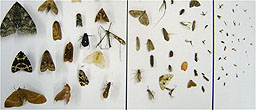 |
| |
2007
Ashrafi S, Bontadina F,
Kiefer A, Pavlinic I, Arlettaz R. 2007. Presence of a third Plecotus bat species
in the Swiss Alps confirmed by morphology and DNA. Biology07 Conference. (pdf)
Deplazes, P, Hegglin, D. 2007. Fuchsbandwurm: In der Schweiz erkranken
deutlich mehr Menschen an Alveolärer Echinococcose. BVET-Magazin 3/2007. (pdf,
0.2 MB)
Hegglin, D, Bontadina, F, Contesse, P, Gloor, S & Deplazes,
P. 2007. Plasticity of predation behaviour as a putative driving force for
parasite life-cycle dynamics: the case of urban foxes and Echinococcus multilocularis
tapeworm. Functional Ecology, 21:552-560. (pdf,
0.23 MB)
Hegglin, D. 2007. Begegnung mit Nachbar Reineke. SCHULEkonkret.
2007-8:40-42. (pdf,
217 KB) [Heft-Bestellung direkt bei SCHULEkonkret]
Obrist, MK & Bontadina F. 2007. Estimation of bat species detectability
and site occupancy: towards an optimal sampling design for the Swiss red list
bat survey. Rote Listen Fledermäuse der Schweiz, interner Bericht. 22 S.
Rathey, E, Obrist, M, Bontadina, F, Martinoli, A, Christe, P, Moretti, M.
2007. Response of bats to chestnu orchard restoration in Southern Switzerland
- Biotope conservation and species conservation. Poster at the international
conference "Monitoring
the Effectiveness of Nature Conservation", held at September 3-6, 2007 at
WSL, Birmensdorf. (Abstract pdf,
0.1 MB)
Sattler, T, Bontadina, F, Hirzel, A, Arlettaz, R. 2007. Ecological
niche modelling of two cryptic bat species calls for a reassessment of their conservation
status. Journal of Applied Ecology, 44:1188-1199. (pdf,
0.7 MB)
2006
Bontadina, F. 2006:
Ganz schön wild - Füchse in Zürich! Zur Tagung "Wildschweine
in Berlin, Füchse in Zürich: Die Dynamik der Stadtökologie zu Beginn des 21. Jahrhunderts".
Schriftenreihe "Denkanstösse" der Stiftung Natur und Umwelt Rheinland-Pfalz.
S. 24-27, (im Druck).
Bontadina F. 2006: Man kann nur fördern,
was man versteht! FlederNews 6, Bernische Informationsstelle für Fledermausschutz
BIF.
(pdf, 295 KB).
Bontadina, F, Sattler, T. 2006: Windenergie in Deutschland und Frankreich:
Sorgen wegen Fledermäusen - und die Lösungssuche. Fledermaus-Anzeiger
83, 1-3. (pdf,
0.8 MB).
Gloor, S, Bontadina, F & Hegglin, D. 2006: Stadtfüchse
- ein Wildtier erobert den Siedlungsraum. Haupt Verlag, Bern, 200 S. [Bestellung
direkt beim Haupt
Verlag oder bei Amazon]
Tanner F, Hegglin D, Thoma R, Brosi G, Deplazes P. 2006. Echinococcus
multilocularis in Grisons: distribution in foxes and presence of potential intermediate
hosts. Schweizer Archiv für Tierheilkunde, 148:501-510. (pdf,
140 KB).
Sattler, T, Schorcht, W, Hirzel, AH, Arlettaz, R & Bontadina,
F. 2006. GIS habitat suitability models identify species-specific bat hotspots:
from home range to landscape scale. Bat Conservation Trust Conference, Reading,
UK. (pdf, 90 KB).
Szentkuti S, Bontadina F, Moretti M, Spada M, Zambelli N, Martinoli A, Arlettaz
R. 2006: The role of traditionally managed chestnut orchards as foraging and
roosting areas for the migratory bat Nyctalus leisleri. Poster at 1st European
Congress of Conservation Biology - Hungary, 161 (abstract,
20 KB; poster,
1.3 MB).
Sattler T, Bontadina F, Arlettaz R. 2006: Ecological factors
affecting the distribution of the sibling bat species Pipistrellus pygmaeusand
Pipistrellus pipistrellusin Switzerland. Poster at 1st European Congress of
Conservation Biology - Hungary (abstract,
40 KB; poster,
415 KB).
Bontadina, F, Hotz, T & Märki, K 2006: Die Kleine
Hufeisennase im Aufwind. Ursachen der Bedrohung, Lebensraumansprüche und Förderung
einer Fledermausart. Haupt Verlag, Bern, 79 S. [Bestellung direkt beim Haupt
Verlag oder bei Amazon]
(pdf
mit Amazon Hinweis)
Sattler, T & Bontadina, F. 2006: Diversity
and activity of bats at two planned wind energy plants: baseline data for site
selection. Student Conference on Conservation Science, University of Cambridge,
March 28-30 2006. Poster (pdf
Abstract, 40 KB)
| |
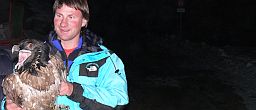 | | |
2005
Kistler C. 2005: Environmental
Enrichment for Red Foxes in Zoos and Wildlife Parks - a work in progress.
Poster Zool. Inst. UniZH. (pdf,
881 KB).
Fischer C, Reperant LA, Weber J-M, Hegglin D, Deplazes P. 2005.
Echinococcus multilocularis infections of rural, residential and urban foxes
(Vulpes vulpes) in the canton of Geneva, Switzerland. Parasite, 12:339-346.
(pdf, 1095KB) Moretti
M, Zambelli N, Bontadina F, Martinoli A, Roesli M. 2005: Progetto SELPI - Selve
e Pipistrelli. Gestione delle selve castanili: cosa possiamo imparare dai pipistrelli?
BatInfo 1/2005. (pdf,
20 KB).
| |
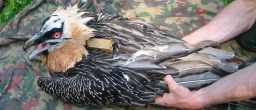 |
| |
2004
Bontadina F, Britschgi A,
Theiler A. 2004: Use of an artificial hedgerow as flight path by an endangered
bat species: a field experiment and its implications for conservation. Proceedings
of the Society for Conservation Biology - 18th Annual Meeting, New York. (pdf,
39 KB) Contesse P, Hegglin D, Gloor S, Bontadina F, Deplazes P. 2004. The
diet of urban foxes (Vulpes vulpes) and the availability of anthropogenic food
in the city of Zurich, Switzerland. Mammalian Biology, 2004, 69:81-95. (pdf,
154 KB) Deplazes P, Hegglin D, Gloor S, Romig T. 2004. Wilderness in
the city: the urbanization of Echinococcus multilocularis. Trends in Parasitology,
20:77-84. (pdf,
1.3 MB) Hegglin D, Bontadina F, Gloor S, Romer J, Müller
U, Breitenmoser U, Deplazes P. 2004. Baiting red foxes in an urban area: a
camera trap study. Journal of Wildlife Management, 68: 1010-1017. (pdf,
99 KB) Schwarzenbach GA, Hegglin D, Stieger C, Deplazes P, Ward PI. 2004:
An experimental field approach to parasitism and immune defense in voles. Parasitology
129: 93-99. (pdf,
105 KB) Sattler T, Bontadina F, Arlettaz R. 2004. From scientific results
to a conservation strategy: The case of the Soprano Pipistrelle Bat (Pipistrellus
pygmaeus) in Switzerland. Student Conference on Conservation Science, University
of Cambridge, 24-26 March 2004. Poster (pdf,
215 KB). | | 
| | >
top |
2003
Bontadina F, Arlettaz, R. 2003. A heap of feathers does not
make a bat's diet. Functional Ecology 17:141-145. (pdf,
117 KB)
Dip R, Hegglin D, Deplazes P, Dafflon O, Koch H, Naegeli H. 2003.
Age- and sex-dependent distribution of persistent organochlorine pollutants
in urban foxes. Environmental Healt Perspectives, 111:1608-1612. (pdf,
246KB) Hegglin D. 2003. The fox tapeworm (Echinococcus multilocularis)
and the red fox (Vulpes vulpes) in the urban habitat: ecological and epidemiological
aspects and an evaluation of an intervention strategy. PhD Thesis, Zoological
Museum, University of Zurich. pp 229. (pdf,
1.35 MB). Hegglin D, Ward P, Deplazes P. 2003. Anthelmintic baiting of
foxes against urban contamination with Echinococcus multilocularis. Emerging
Infectious Diseases 9:1266-1277. (pdf,
317 KB). Hegglin D, Ward P, Deplazes P. 2003. Lowered Echinococcus multilocularis
egg contamination in urban areas due to anthelmintic baiting of foxes. Swiss
Medical Weekly 133(Suppl 134):S 67. (pdf) Sattler
T, Bontadina F, Arlettaz R. 2003. Ecological factors affecting the distribution
of the sibling bat species Pipistrellus pygmaeusand Pipistrellus pipistrellusin
Switzerland. Student Conference on Conservation Science University of Cambridge
26-28 March 2003. Poster (pdf,
415 KB). Schmied S, Bontadina F, Beck A & Arlettaz R. 2003. Does food
scarcity limit the current distribution of the once widespread lesser horseshoe
bat (Rhinolophus hipposideros)? 77. Annual Meeting of the DGS, 23. Congress
of the SGW, Bern, 21. to 25. September 2003: 61. Wandeler P, Funk SM, Largiadér
CR, Gloor S & Breitenmoser U. 2003. The city-fox phenomenon: genetic consequences
of a recent colonization of urban habitat. Molecular Ecology 12:647-656. (pdf,
291 KB) | |
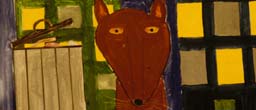 |
| >
top |
2002
Bontadina F, Naef-Daenzer B, Schofield H. 2002. Radio-tracking
reveals that lesser horseshoe bats (Rhinolophus hipposideros) forage in woodland.
Journal of Zoology 258:281-290. (pdf,
128 KB) Bontadina, F. 2002. Conservation ecology in the horseshoe bats
Rhinolophus ferrumequinum and Rhinolophus hipposideros. PhD Thesis, University
of Bern. pp 184. (online). Deplazes
P, Gloor S, Stieger C, Hegglin D. 2002. Urban transmission of Echinococcus
multilocularis. In: Craig P, Pawlowski Z, editors; 2002. Cestode Zoonoses:
Echinococcosis and Cysticercosis. IOS Press, Amsterdam, Netherlands. p 287-297.
Gloor, S. 2002. The Rise of Urban Foxes (Vulpes vulpes) in Switzerland
and Ecological and Parasitological Aspects of a Fox Population in the Recently
Colonised City of Zurich. PhD
Thesis, Zoological Museum, University of Zurich. Speiser, B, Kistler,
C. 2002. Field tests with a molluscicide containing iron phosphate. Crop
Protection 21: 389-394. (pdf,
131 KB). Stieger C, Hegglin D, Schwarzenbach G, Mathis A, Deplazes P. 2002.
Spatial and temporal aspects of urban transmission of Echinococcus multilocularis.
Parasitology 124:631-640. (pdf,
281 KB). | |
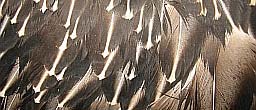 |
| >
top |
2001
Bontadina F, Gloor S, Hegglin D, Hotz T, Stauffer C. 2001. INFOX
- Kommunikation für ein konfliktarmes Zusammenleben von Menschen und Stadtfüchsen.
Eidg. Forschungsanstalt für Wald, Schnee und Landschaft [WSL] - Forest Snow
and Landscape Research 76:267-284. (pdf,
84 KB)
Bontadina F, Contesse P, Gloor S. 2001. Wie beeinflusst die persönliche
Betroffenheit die Einstellung gegenüber Füchsen in der Stadt? Eidg. Forschungsanstalt
für Wald, Schnee und Landschaft [WSL] - Forest Snow and Landscape Research 76:255-266.
(pdf,
60 KB) Breitenmoser-Würsten C, Robin K, Landry J-M, Gloor S, Olsson P, Breitenmoser
U. 2001. Die Geschichte von Fuchs, Luchs, Bartgeier, Wolf und Braunbär in der
Schweiz - ein kurzer Überblick. Eidg. Forschungsanstalt für Wald, Schnee und
Landschaft [WSL] - Forest Snow and Landscape Research 76:9-21. Dip R, Stieger
C, Deplazes P, Hegglin D, Muller U, Dafflon O, Koch H, Naegeli H. 2001. Comparison
of heavy metal concentrations in tissues of red foxes from adjacent urban, suburban,
and rural areas. Archives of Environmental Contamination and Toxicology 40:551-556.
Gloor S, Bontadina F, Hegglin D, Deplazes P, Breitenmoser U. 2001. The
rise of urban fox populations in Switzerland. Mammalian Biology 66:155-164.
(doc,
2.7 MB!) Hegglin D, Gloor S, Stieger C, Schwarzenbach G, Deplazes P. 2001.
Echinococcus multilocularis transmission in urban areas. XXth International
Congress of Hydatology, 03.-09.06.2001; Kusadasi, Turkey, 99. (pdf) | |
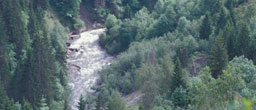
| | >
top |
2000
Bontadina F, Arlettaz R, Fankhauser T, Lutz M, Mühlethaler E,
Theiler A, Zingg P. 2000. The lesser horseshoe bat Rhinolophus hipposideros
in Switzerland: present status and research recommendations. Le Rhinolophe
14:69-83. (pdf,
830 KB)
Bontadina F, Arlettaz R. 2000. Rhinolophus hipposideros 2000.
Research program for the conservation of the lesser horseshoe bat Rhinolophus
hipposideros in Switzerland. Report for the Swiss Coordination Centre for
the Study and Protection of Bats. 25 p. Gloor S, Bontadina F, Hegglin D,
Hotz T. 2000. Füchse im Siedlungsraum. Wildbiologie 6(32).
Hegglin D, Märki K. 2000. Monitoring juvenile Bearded Vultures in
the Swiss National Park and the Parco Nazionale dello Stelvio. Bearded Vulture
- Reintroduction into the Alps Annual report 2000, 47-57. (pdf) Hofer
S, Gloor S, Muller U, Mathis A, Hegglin D, Deplazes P. 2000. High prevalence
of Echinococcus multilocularis in urban red foxes (Vulpes vulpes) and voles (Arvicola
terrestris) in the city of Zurich, Switzerland. Parasitology 120:135-142.
(pdf, 894 KB). Märki
K, Nievergelt B, Gigon A, Schütz M. 2000. Impact of selective foraging by red
deer on the long-term vegetation development in the Swiss National Park. In:
Schütz M, Krüsi BO, Edwards PJ (eds): Succession research in the Swiss National
Park. Nationalpark-Forschung Schweiz 89, 189 206 Schütz M, Wildi O, Krüsi
BO, Märki K, Nievergelt B. 2000. From tall-herb communities to pine forests:
distribution patterns of 121 plant species during a 585-year regeneration process.
Nationalpark-Forschung in der Schweiz:237-255. 1999
Bontadina,
F, Gloor, S, Hotz, T. 1999. Urban hedgehogs in Zurich, Switzerland: spatial
distribution & habitat use. Third International Hedgehog Workshop 29-30 January
1999 in London, UK. (Abstract). Bontadina
F, Schofield H, Naef-Daenzer B. 1999. Habitat preference in lesser horseshoe
bats as revealed by radiotracking. Bat Research News 40:110-111. Bontadina
F, Scaravelli D, Gloor S, Hotz T, Beck A. 1999. Radio-tracking bats: A short
review with examples of a study in Italy. Pp 163-173. In Atti 1º Convegno
Italiano sui Chirotterri, Castell’ Azzara (G. DONDINI, O. PAPA LINI, and S. VERGARI,
eds.). G.S.l’Orso, Castell’ Azzara, Grosseto, 360 pp. Bontadina F, Naef-Daenzer
B. 1999. Die räumliche Verteilung waldbewohnender Vogelarten in Abhängigkeit
von Waldstruktur und immissionsbedingten Waldschäden. II. Nadelwälder in Graubünden.
Der Ornithologische Beobachter 96:95-116. (pdf)
Gloor, S., Hotz, Th., Bontadina, F. & Hegglin, D. (1999): Füchse in unseren
Wohngebieten - Leben mit einem Wildtier. Ratgeber für die Stadt Zürich, Kanton
und Stadt Schaffhausen und den Kanton Bern. Arbeitsgemeinschaft Stadtökologie
und Wildtierforschung, Zürich, 49 S. 1998
Bontadina F, Hegglin
D, Gloor S, Hotz T, Stauffer C. 1998. Information on foxes in Zurich's backyards:
the INFOX programme. KORA Report Nr.3. Deplazes P, Mathis A, Hofer
S, Gloor S, Bontadina F, , Hegglin D, Müller U, Eckert J. 1998. Urban cycle
of Echinococcus multilocularis and risk assessment of infections of domestic dogs
and cats. Parasitology International 47(1): 163. (pdf,
142 KB). Hegglin D, Gajdon G, Good T, Getenet A, Gebremedhin B, Imfeld S,
Lustenberger J, Niederberger J. 1998. Larger mamals and birds in the Lowlands
and on the Plateau of the Park. A survey on the Flora and Fauna of the Simen Mountains
National Park. Nievergelt B, Good T, Güttinger R (Walia special issue eds.):
A survey on the Flora and Fauna of the Simen Mountains National Park. Pano-Verlag,
Zürich, Switzerland, p 52-63. (pdf,
2.1 MB) Hegglin D, Bontadina F, Gloor S. 1998. From the alpine to the
urban fox - adaptive behaviour of the red fox (Vulpes vulpes). Advances in
Ethology, 1998, Berlin, Germany. Advances in Ethology, Supplements to Ethology
33:119. (pdf, 11
KB). Ward PI, Mosberger N, Kistler C, Fischer O. 1998. The relationship
between popularity and body size in zoo animals. Conservation Biology 12:1408-1411. 1997
Beck A, Gloor S, Zahner M, Bontadina F, Hotz T, Lutz M, Mühlethaler E. 1997. Zur
Ernährungsbiologie der Grossen Hufeisennase Rhinolophus ferrumequinum in einem
Alpental der Schweiz. In: Ohlendorf B, editor. Zur Situation der Hufeisennasen
in Europa. Berlin: IFA. p 15-18. (pdf) Bontadina
F, Hotz T, Gloor S, Beck A, Lutz M, Mühlethaler E. 1997. Schutz von Jagdgebieten
von Rhinolophus ferrumequinum. Umsetzung der Ergebnisse einer Telemetrie-Studie
in einem Alpental der Schweiz. In: Ohlendorf B, editor. Zur Situation der
Hufeisennasen in Europa. Berlin: IFA. p 33-39. Märki K. 1997. Nahrungswahlverhalten
von Rothirschen (Cervus elaphus L. ) auf zwei subalpinen Weiden im Schweizerischen
Nationalpark. Diplomarbeit, 67 S. Wechsler B, Hegglin D. 1997. Individual
differences in sow behaviour and crushing of piglets. Applied Animal Behaviour
Science 51:39-49. (pdf,
580 KB). 1996
ASHG (Arbeitsgruppe zum Schutz der Hufeisennasen
Graubündens: A. Beck F. Bontadina, S. Gloor, T. Hotz, M. Lutz, E. Mühlethaler).
1996. Wo jagen die letzten Grossen Hufeisennasen? Wildbiologie
6/25:12p. Bontadina, F, Gloor, S, Hotz, T. 1996. Urban hedgehogs
in Zurich, Switzerland: spatial distribution and habitat use. First international
hedgehog workshop 25 - 28 APRIL 1996, Arendal. (Abstract). Bontadina
F, Naef-Daenzer B. 1996. Analysing spatial data of different accuracy: the
case of greater horseshoe bats foraging. In: Le Maho, Y. (ed.). Wildlife -
Biotelemetry. CNRS-CEPE, Strasbourg. [ Proceeding was never printed! ] ( online
http://swild.ch/publi/Bontadina_WilTel1996.pdf, pdf). vor
1996
Bontadina F, Beck A, Gloor, S, Hotz, T, Lutz, M, Mühlethaler,
E. 1995. Jagt die Grosse Hufeisennase Rhinolophus ferrumequinum im Wald? -
Grundlagen zum Schutz von Jagdgebieten der letzten grösseren Kolonie in der Schweiz.
Der Ornithologische Beobachter 92:325-327 (pdf,
400 KB).
Gloor, S., H. P. B. Stutz, et al. (1995). Nutritional habits
of the Noctule bat Nyctalus noctula (Schreber, 1774) in Switzerland. Myotis
32-33: 231-242. (pdf,
281 KB).
Beck, A., Bontadina, F., Gloor, S., Hotz, T., Lutz, M. & Muehlethaler,
E. (1994). Jagdhabitatwahl und nächtliche Aufenthaltsgebiete der Grossen Hufeisennase
(Rhinolophus ferrumequinum) in Raum Castrich/GR. Arbeitsgruppe zum Schutz
der Hufeisennasen Graubündens ASGH, Encarden 51, 7152 Sagogn, Schweiz. 102 Seiten.
Beck A, Bontadina F, Gloor S, Hotz T, Lutz M, Mühlethaler E. 1994.
Preliminary results regarding activity pattern and foraging areas of Rhinopholus
ferrumequinum in an alpine valley of Switzerland. Bat Research News 35:16.
Beck A, Bontadina F, Gloor S, Hotz T, Scaravelli D. 1994. First report of Myotis
natteri in Romagna (Mammalia, Vespertilionidae). Quaderno di Studi e Notizie
di Storia Naturale della Romagna, 3:63-66. (pdf) Beck
A, Bontadina F, Gloor S, Hotz T, Scaravelli D. 1994. Preliminary results on
the ecology of Rhinolophus ferrumequinum in Romagna (northern Italy). Università
degli Studi di Pisa e Siena, Pisa. p 12. Bontadina F, Gloor S, Hotz T.
1994. Igel in der Stadt. Wildbiologie
6(21), 14p.
Bontadina F, Sandra G. 1994. How the noctule bat Nyctalus
noctula selects its roosts in the area of the town of Zurich, Switzerland.
Bat Research News 35:18.
Zingg R. 1994. Aktivität, sowie Habitat-
und Raumnutzung von Igeln (Erinaceus europaeus) in einem ländlichen Siedlungsgebiet.
Dissertation an der Phil. Fak. II der Universität Zürich, 110 Seiten.
(pdf, Kontakt zur Dr.
Robert Zingg: email)
Bontadina
F, Gloor S, Hotz T. 1993. Igel Erinaceus europaeus in der Stadt Zürich.
Revue Suisse Zoologie 100:797. Gloor S, Stutz HPB, Ziswiler V. 1994. Nutritional
habits of the noctule bat Nyctalus noctula in the northern part of Switzerland.
Bat Research News 35:23.
Bontadina, F, Gloor, S, Hotz, T. 1993.
Igel - Wildtiere in der Stadt. Grundlagen zur Förderung der Igel in Zürich.
Bericht im Auftrag der Fachstelle Naturschutz des Gartenbau- und Landwirtschaftsamt
der Stadt Zürich. Januar 1993, 68 Seiten. (pdf,
15 MB)
Bontadina, F, Gloor, S, Hemmi, M. 1991. Grundlagen zum Schutz
des Grossen Abendseglers der typischen baumhöhlenbewohnenden Fledermausart
in den Wäldern der Stadt Zürich. Report city of Zurich (pdf
online Version, 1.9 MB) Bontadina F, Gloor S, Hemmi M. 1991. Artenschutzforschung
führt zu Biotopschutzkonzepten. Forstwirtschaftliche Massnahmen zum Schutze baumhöhlenbewohnender
Fledermausarten. Fledermaus-Anzeiger:4-5. (pdf,
2.1 MB)
Gloor S. 1991. Nutritional habits of the noctule bat Nyctalus
noctula in the northern part of Switzerland. Bat Research News 32:14-15.
Bontadina, F. 1991. Strassenüberquerungen von Igeln (Erinaceus europaeus).
Diplomarbeit am Zoologischen Institut der Universität Zürich. (pdf,
9 MB). Hotz T, Güntert M. 1987. A decrease in the adoption
of unfamiliar young by the blackbird Turdus merula. Der Ornithologische Beobachter
84:136-137. | |
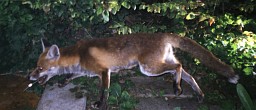
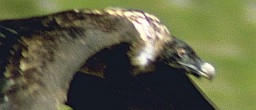
|
> top |


